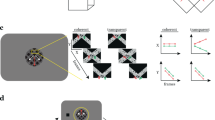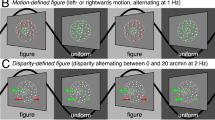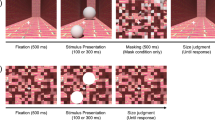Abstract
Common situations that result in different perceptions of grouping and border ownership, such as shadows and occlusion, have distinct sign-of-contrast relationships at their edge-crossing junctions. Here we report a property of end stopping in V1 that distinguishes among different sign-of-contrast situations, thereby obviating the need for explicit junction detectors. We show that the inhibitory effect of the end zones in end-stopped cells is highly selective for the relative sign of contrast between the central activating stimulus and stimuli presented at the end zones. Conversely, the facilitatory effect of end zones in length-summing cells is not selective for the relative sign of contrast between the central activating stimulus and stimuli presented at the end zones. This finding indicates that end stopping belongs in the category of cortical computations that are selective for sign of contrast, such as direction selectivity and disparity selectivity, but length summation does not.
This is a preview of subscription content, access via your institution
Access options
Subscribe to this journal
Receive 12 print issues and online access
$209.00 per year
only $17.42 per issue
Buy this article
- Purchase on Springer Link
- Instant access to full article PDF
Prices may be subject to local taxes which are calculated during checkout







Similar content being viewed by others
References
Adelson, E.H. Lightness perception and lightness illusions. in The New Cognitive Neurosciences (ed. M. Gazzaniga) 339–351 (MIT Press, Cambridge, MA, 2000).
Attneave, F. Some informational aspects of visual perception. Psychol. Rev. 61, 183–193 (1954).
Beck, J., Prazdny, K. & Ivry, R. The perception of transparency with achromatic colors. Percept. Psychophys. 35, 407–422 (1984).
Watanabe, T. & Cavanagh, P. The role of transparency in perceptual grouping and pattern recognition. Perception 21, 133–139 (1992).
Watanabe, T. & Cavanagh, P. Transparent surfaces defined by implicit X junctions. Vision Res. 33, 2339–2346 (1993).
Watanabe, T. & Cavanagh, P. Surface decomposition accompanying the perception of transparency. Spat. Vis. 7, 95–111 (1993).
Grossberg, S. & Yazdanbakhsh, A. Laminar cortical dynamics of 3D surface perception: stratification, transparency, and neon color spreading. Vision Res. 45, 1725–1743 (2005).
Howe, P.D. & Livingstone, M.S. V1 partially solves the stereo aperture problem. Cereb. Cortex, published online 23 November 2005 (doi:10.1093/cercor/bhj077).
Pack, C.C., Born, R.T. & Livingstone, M.S. Two-dimensional substructure of stereo and motion interactions in macaque visual cortex. Neuron 37, 525–535 (2003).
Pack, C.C. et al. End-stopping and the aperture problem: two-dimensional motion signals in macaque V1. Neuron 39, 671–680 (2003).
Hubel, D.H. & Wiesel, T.N. Receptive fields, binocular interaction and functional architecture in the cat's visual cortex. J. Physiol. (Lond.) 160, 106–154 (1962).
Hammond, P. & Munden, I.M. Areal influences on complex cells in cat striate cortex: stimulus-specificity of width and length summation. Exp. Brain Res. 80, 135–147 (1990).
Gilbert, C.D. Laminar differences in receptive field properties of cells in cat primary visual cortex. J. Physiol. (Lond.) 268, 391–421 (1977).
Grieve, K.L. & Sillito, A.M. The length summation properties of layer VI cells in the visual cortex and hypercomplex cell end zone inhibition. Exp. Brain Res. 84, 319–325 (1991).
Ohzawa, I. & Freeman, R.D. The binocular organization of complex cells in the cat's visual cortex. J. Neurophysiol. 56, 243–259 (1986).
Movshon, J.A., Thompson, I.D. & Tolhurst, D.J. Receptive field organization of complex cells in the cat's striate cortex. J. Physiol. (Lond.) 283, 79–99 (1978).
Livingstone, M. & Conway, B.R. Substructure of direction-selective receptive fields in macaque V1. J. Neurophysiol. 89, 2743–2759 (2003).
Szulborski, R.G. & Palmer, L.A. The two-dimensional spatial structure of nonlinear subunits in the receptive fields of complex cells. Vision Res. 30, 249–254 (1990).
Hubel, D.H. & Wiesel, T.N. Receptive fields and functional architecture in two nonstriate visual areas (18 and 19) of the cat. J. Neurophysiol. 28, 229–289 (1965).
Schiller, P.H., Finlay, B.L. & Volman, S.F. Quantitative studies of single-cell properties in monkey striate cortex. I. Spatiotemporal organization of receptive fields. J. Neurophysiol. 39, 1288–1319 (1976).
Bolz, J. & Gilbert, C.D. Generation of end-inhibition in the visual cortex via interlaminar connections. Nature 320, 362–365 (1986).
Dobbins, A., Zucker, S.W. & Cynader, M.S. Endstopped neurons in the visual cortex as a substrate for calculating curvature. Nature 329, 438–441 (1987).
Dobbins, A., Zucker, S.W. & Cynader, M.S. Endstopping and curvature. Vision Res. 29, 1371–1387 (1989).
DeAngelis, G.C., Freeman, R.D. & Ohzawa, I. Length and width tuning of neurons in the cat's primary visual cortex. J. Neurophysiol. 71, 347–374 (1994).
Cleland, B.G., Lee, B.B. & Vidyasagar, T.R. Response of neurons in the cat's lateral geniculate nucleus to moving bars of different length. J. Neurosci. 3, 108–116 (1983).
Rose, D. Mechanisms underlying the receptive field properties of neurons in cat visual cortex. Vision Res. 19, 533–544 (1979).
Sillito, A.M. & Versiani, V. The contribution of excitatory and inhibitory inputs to the length preference of hypercomplex cells in layers II and III of the cat's striate cortex. J. Physiol. (Lond.) 273, 775–790 (1977).
Anderson, J.S. et al. Membrane potential and conductance changes underlying length tuning of cells in cat primary visual cortex. J. Neurosci. 21, 2104–2112 (2001).
Heeger, D.J. Normalization of cell responses in cat striate cortex. Vis. Neurosci. 9, 181–197 (1992).
Nelson, J.I. & Frost, B.J. Orientation-selective inhibition from beyond the classic visual receptive field. Brain Res. 139, 359–365 (1978).
DeAngelis, G.C. et al. Organization of suppression in receptive fields of neurons in cat visual cortex. J. Neurophysiol. 68, 144–163 (1992).
Sillito, A.M., Cudeiro, J. & Murphy, P.C. Orientation sensitive elements in the corticofugal influence on centre-surround interactions in the dorsal lateral geniculate nucleus. Exp. Brain Res. 93, 6–16 (1993).
Murphy, P.C. & Sillito, A.M. Corticofugal feedback influences the generation of length tuning in the visual pathway. Nature 329, 727–729 (1987).
Orban, G.A., Kato, H. & Bishop, P.O. Dimensions and properties of end-zone inhibitory areas in receptive fields of hypercomplex cells in cat striate cortex. J. Neurophysiol. 42, 833–849 (1979).
Cavanaugh, J.R., Bair, W. & Movshon, J.A. Selectivity and spatial distribution of signals from the receptive field surround in macaque V1 neurons. J. Neurophysiol. 88, 2547–2556 (2002).
Tanaka, K. et al. Receptive field properties of cells in area 19 of the cat. Exp. Brain Res. 65, 549–558 (1987).
Nakayama, K., He, Z. & Shimojo, S. Visual surface representation: a critical link between lower-level and higher-level vision. in Visual Cognition: An Invitation to Cognitive Science (eds. S.M. Kosslyn & D. Osherson) 1–70 (MIT Press, Cambridge, Massachusetts, 1995).
He, Z.J. & Nakayama, K. Surfaces versus features in visual search. Nature 359, 231–233 (1992).
Rensink, R.A. & Enns, J.T. Early completion of occluded objects. Vision Res. 38, 2489–2505 (1998).
Nakayama, K., Shimojo, S. & Silverman, G.H. Stereoscopic depth: its relation to image segmentation, grouping, and the recognition of occluded objects. Perception 18, 55–68 (1989).
Driver, J. & Baylis, G.C. Edge-assignment and figure-ground segmentation in short-term visual matching. Cognit. Psychol. 31, 248–306 (1996).
Zhou, H., Friedman, H.S. & von der Heydt, R. Coding of border ownership in monkey visual cortex. J. Neurosci. 20, 6594–6611 (2000).
Born, R.T. et al. Segregation of object and background motion in visual area MT: effects of microstimulation on eye movements. Neuron 26, 725–734 (2000).
Livingstone, M.S. Mechanisms of direction selectivity in macaque V1. Neuron 20, 509–526 (1998).
Judge, S.J., Richmond, B.J. & Chu, F.C. Implantation of magnetic search coils for measurement of eye position: an improved method. Vision Res. 20, 535–538 (1980).
Livingstone, M.S., Pack, C.C. & Born, R.T. Two-dimensional substructure of MT receptive fields. Neuron 30, 781–793 (2001).
Emerson, R.C. et al. Nonlinear directionally selective subunits in complex cells of cat striate cortex. J. Neurophysiol. 58, 33–65 (1987).
Acknowledgements
We thank D. Freeman for developing computer programs; T. Chuprina for technical assistance; R. Rajimehr for helpful input; C. Libedinsky for discussion; and D. Tsao for an analysis framework. This work was supported by a grant from the National Eye Institute (EY13135).
Author information
Authors and Affiliations
Corresponding author
Ethics declarations
Competing interests
The authors declare no competing financial interests.
Rights and permissions
About this article
Cite this article
Yazdanbakhsh, A., Livingstone, M. End stopping in V1 is sensitive to contrast. Nat Neurosci 9, 697–702 (2006). https://doi.org/10.1038/nn1693
Received:
Accepted:
Published:
Issue Date:
DOI: https://doi.org/10.1038/nn1693
This article is cited by
-
Precise visuomotor transformations underlying collective behavior in larval zebrafish
Nature Communications (2021)
-
Collinear search impairment is luminance contrast invariant
Scientific Reports (2021)



